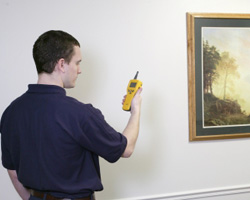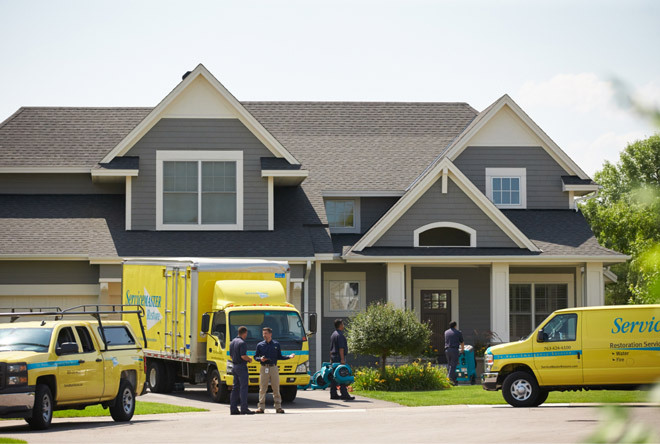Wichita Mold Remediation & Removal
Protect your home and family from the effects of mold
Mold is an increasingly growing concern for property managers, homeowners, and restoration service providers. Mold does not need much time and can grow in as little as 48 hours wherever high levels of moisture and humidity are present. If you’re concerned with air quality, mold has been identified as a key contributor for creating allergies and poor air quality. Despite the known common knowledge about mold, many still do not understand the scope of how dangerous mold can be. We’ve provided some information that we hope will educate and help you make better decisions regarding mold.
Common Mold Questions
What is mold?
Mold is a microscopic life form whose purpose is to decay organic materials. Many species of mold have been discovered, and while they are all different, many share a number of common characteristics:
- Mold lives off of organic food sources. A common source found in buildings is cellulose, which is found in structural materials such as wood and drywall.
- Mold requires a moisture-rich environment to live in.
- Mold can spread seed-like particles called ‘spores’ which can land elsewhere and grow.
Why is it a problem?
- Working or living in mold-contaminated environments raises the risk of a number of health complications.
- Mold will eventually break down whatever surface it grows on and will destroy it, given enough time.
- Mold can produce a nasty, musty odor.
- Mold is visually unappealing and mars the look of your home/office.
What is a reasonable & safe response?
If mold is present, moldy materials must be either removed or decontaminated through a process calledmold remediation. Proper remediation procedures will be determined by the scope, size and severity of damages the mold has caused.
Here is a helpful guide provided by the U.S. Environmental Protection Agency (EPA) for homeowners about the removal and cleanup of mold in homes. This guide is titled, A Brief Guide to Mold, Moisture and Your Home, and can be found on the EPA website at http://www.epa.gov/mold/moldguide.html
ServiceMaster DSI is ready to help
ServiceMaster DSI has the proper training and equipment to manage mold situations in homes and businesses. During any of ServiceMaster DSIservices, if our technicians encounters mold, they can remediate mold growths that fall into the size of 10 square feet or less. If there are mold growths that are larger, a certified mold remediator is required, one who we may be able to provide or refer you to.
Act Immediately
Because mold can grow in as little as 48 hours, you must implement the
proper techniques immediately to prevent mold growth. Call the specialists
at ServiceMaster DSI to fix the source of the moisture and dry, sanitize
and vacuum the area to prevent mold from developing.
Contact our expert teamonline or call(316) 348-4464 to schedule a mold remedation service today!
WICHITA MOLD REMEDIATION CHECK LIST
The following list is intended to inform you of the general elements and procedures during a mold remediation service. Please note that not everything mentioned below is part of every service, as every case of mold is different and different actions plans are needed.
Prevent Cross Contamination and Seal Off Areas: Mold spores are microscopic, very light, and travel within the air. In an attempt to remove mold, spores may be released while a technician is remediating the mold. Barriers and sealing off rooms may be needed to ensure mold spores do not spread into other areas of the property.
HEPA Filtration Units: High Efficiency Particle Arrestors (HEPA) filtering units must be used. HEPA filtration devices may be used throughout the remediation service. HEPA filtration units should be running at least 72-120 hours after any remediation service is completed.
Covering the Floors: Covering the floors with plastic coverings prevents soiling and mold spores from hiding within the carpet fibers.
Ceiling and Wall Materials: Mold contaminated materials may need to be removed and replaced due to the inability to completely remove mold and its spores from porous materials.
Decontaminating Walls, Floors, and Ceilings: Eliminating mold that has found its way into the nooks and crannies of a building is crucial. Any tiny leftover growth of mold will only expand and grow, creating a never-ending cycle of mold growth. Simply sealing over a troubled area isn’t going to make the problem go away and opting to use spray cleansers as a substitute for proper cleaning should be completely avoided.
DETAILED CLEANING: Areas should be cleaned as meticulously as possible since microorganisms and spores thrive in dust and dirt. The areas should be cleaned thoroughly and structural materials should be HEPA vacuumed while the area is still under negative pressure.
DRYING OF STRUCTURAL MATERIALS: All structural materials should be thoroughly dried to within 10% (or less) of their normal moisture content before any type of encapsulant (sealant) can be applied.
ENCAPSULATE DECONTAMINATED AREAS WITH APPROVED ENCAPSULANT:Once thoroughly cleaned and inspected, areas should be sealed with an approved encapsulant; standard primers and sealers are generally not sufficient. Water based products should also be discouraged since they may increase the problem by feeding it with more moisture (a primary source of growth).
HVAC DUCT CLEANING & SANITIZING: Since mold spores are microscopic and nearly as light as air itself, they are easily drawn through heating and cooling system and the attached ductwork. Spores also tend to lodge in the dirt within these systems as well as in the evaporator coils (the dirty ducts provide all the needed food sources and moisture for mold to grow). Proper duct cleaning should be considered as a standard procedure for mold remediation (sanitizing may also be required in some cases). ServiceMaster DSI also has air duct video inspection equipment available upon request.
DECONTAMINATION OF INDOOR AIR SPACE: After all the above steps are completed, HEPA filtration should continue for AT LEAST 72-120 hours after all remediation and final clean-up is complete. Do not assume that your filtration is a true HEPA filtering device unless it is certified as true HEPA. Simply using HEPA filters does not make a device truly HEPA.
CLEARANCE SAMPLING: Sampling via various methods (cultures, air samples, swab samples, etc.) is often recommended. Since spores are microscopic, the only way to verify and document that the proper cleaning has been completed successfully is to have sampling done by an independent 3rd party. An independent 3rd party, trained in mold remediation and sampling, should take the samples AND interpret the results. Samples should be taken aggressively, i.e. with HVAC system operational, rooms stirred up by doors being opened, furniture being moved, etc. A reference sample should also be taken of outside conditions for analysis and comparison. NOTE -clearance (final) sampling should not be considered until all visible dirt and dust have been removed and the entire area cleaned. It is impossible to remove 100% of all contaminants from surfaces and duct work, but dusty and dirty conditions will not be sufficient to pass final clearance sampling. The most common goal of final clearance sampling is to make the indoor environment air at least equal to or better than outdoor air.
RECONSTRUCTION: Reconstruction should not begin until a suitable clearance has been secured and the company responsible for clearance sampling releases the facility. Pre-mature reconstruction may only hinder full remediation and may even require the demolition or removal of newly installed materials.
If you have spotted mold in your home, turn to our mold removal experts. You can call us at(316) 348-4464 or contact our teamonline.


